Tunnels under Mount Parish
Primary tabs
Have you ever heard of 'Mount Parish' in Hong Kong? The name has fallen out of common use, but the hill is still there, together with its extensive tunnel network and place in Hong Kong's wartime history.
The hill lies on the boundary between Wanchai and Happy Valley, with Kennedy Road on its West, Queen's Road East on the North, and Stubbs Road to the East.
Mount Parish in the Second World War
In the closing stages of the fighting, Mount Parish lay on the front line between the British defending forces, and the Japanese invaders. Major-General C. M. Maltby's Despatch says that by the morning of the 24th December 1941, "The small party of Royal Marines was now patrolling the spurs south of Mount Parish in touch with the 5/7 Rajput Regt. who had collected hospital discharges, etc, and formed a third platoon which had been positioned on the Mount Parish Spur."
That evening, he notes "The direction of the enemy advance on Wanchai made it possible that the enemy might use the A.R.P. tunnels for infiltration, and wardens were warned accordingly. The most important tunnels concerned were those under Mount Parish."
At midday the next day (Christmas Day), his despatch reports "Japanese artillery opened up punctually on a large scale, and later hand to hand fighting was reported by 5/7 Rajput Regt. on Mount Parish, where a platoon was surrounded. Shortly afterwards Mount Parish fell into the enemy's hands, and an advance along Kennedy Road was threatened."
At about the same time, he says "The enemy was now in the Wanchai A.R.P. tunnels (q v para. 135) but about noon an 18 pounder gun had arrived there, which, mounted in the main street, covered several of the exits. A number of rounds were fired at these exits, more as a deterrent than anything else. No casualties were observed to have been caused, and no enemy emerged."
Local historian Tony Banham also commented on that 18-pounder in an article in the SCMP: "For about eight to 10 hours before Hong Kong surrendered, the Wan Chai Market was at the front line of fighting, defending Central from falling into Japanese hands," he said. "A mixed bag of gunners, Hong Kong Volunteers and the Middlesex regiment held the position in an attempt to prevent the Japanese from reaching Central along Kennedy Road. At one point, they had an 18-pounder gun blasting at the Japanese attempting ingress through the air raid shelters under Mount Parish."
However this was some of the last fighting in Hong Kong, shortly before the surrender. Maltby again: "At 1515 hours I advised H.E. The Governor and C.-in-C. that no further useful military resistance was possible and I then ordered all Commanding Officers to break off the fighting and to capitulate to the nearest Japanese Commander, as and when the enemy advanced and opportunity offered."
The Tunnels
The following map shows the extent of the tunnels, with entrances on all the three roads that follow the edge of the hill. (To orient yourself, you can see the edge of Happy Valley racecourse on the right, the round Hopewell Center tower on the right. Click the "+" button to zoom in for more detail.)
http://gwulo.com/articles/mount-parish-tunnel-map.htm
Altogether about 1.8km of tunnels were built here during 1940-41 as part of the preparations for war. Some parts of the tunnels are now inaccessible, but surveys made in the late 1970's and early 1980's reported that the sections of the tunnels that could be accessed were generally in good condition. Those surveys noted that the tunnels are divided into three different levels, with sloping connecting passages.
What's left to see today?
If you've ever driven down Stubbs Road, you'll have noticed this colourful playground:
Portal 83 would have been here, but there is no sign of it now. The East ventilation shaft should also have been here. A scramble through the undergrowth found this lump of concrete in about the right place, but who knows if it is concrete from the tunnel, or just a piece of old drainage culvert? (The records show that the East ventilation shaft had been filled in, so it's not surprising it is hidden.)
Walking down Stubbs Road, there is no sign of Portal 82, but we have better luck when we reach Queen's Road East. Just under the pedestrian footbridge is Portal 81:
This section of the tunnels is one of the few that is still in use, as it is used to store low-level radioactive waste. Someone was found in the tunnel a few years ago - did the glow give him away?
Next is portal 80, providing access when the government check the conditions of the tunnels:
Then just past the entrance to Wah Yan College is portal 79, showing the original shape of the entrance:
No sign of portal 78, but if you look up you can see the top of portal 77, on the corner of Kennedy Road.
Portals 76, 75, and 74, opposite the Wanchai clinic, were covered over when Kennedy Road was realigned in 1964. You can make out some blocky shapes under the sprayed on concrete, which are in about the right place for the portals, but they are not clear enough to be certain:
When you reach the place where Kennedy Road bends to the right, look up the hill and you can see the top of the West ventilation shaft.
Turn your head to the right and you'll see portal 73, also set a little way up the hillside. It was seeing this from the minibus window that started me looking for more information about these tunnels.
Walk a little further along Kennedy Road and you'll see portal 72:
Then cross over the road, and walk down the staircase by the side of the St James Settlement building. This last tunnel runs under Kennedy Road, with portal 71 cut into the side of the embankment. It is not very clear, but I believe this is the site of the portal, just next to the staircase:
Unlike the Kowloon Park tunnels, none of the portals have doors with grills we can see through. I went back to take a closer look at portal 73, which looks as though some bricks were missing:
Here's a long exposure photo through one of the gaps:
This portal is set at an angle to the tunnel behind, so trying again at an angle we can get a look down the tunnel:
Finally, you can also get a better view of the West ventilation shaft from this level:
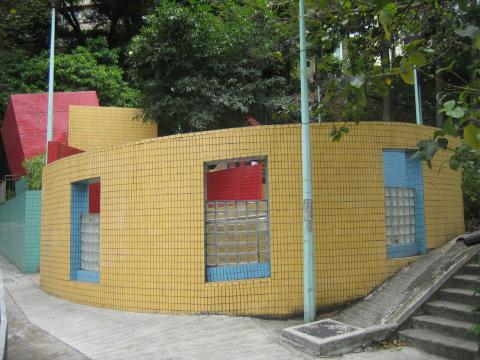
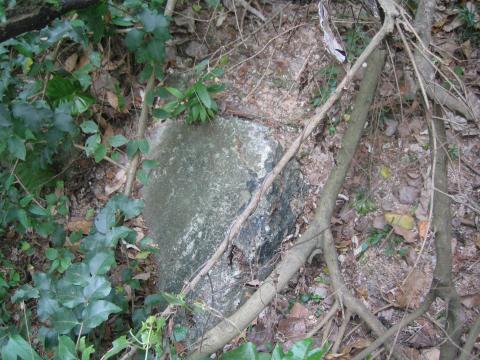

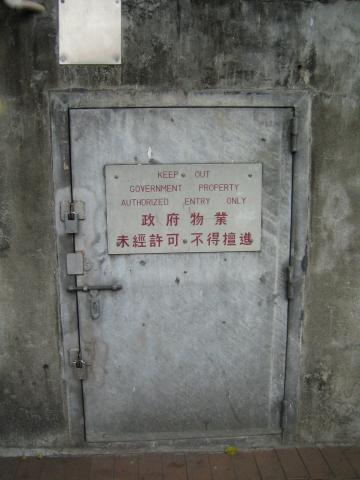

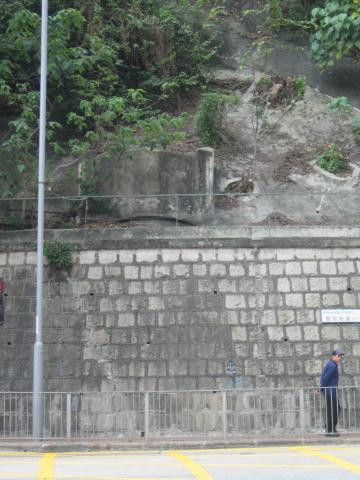
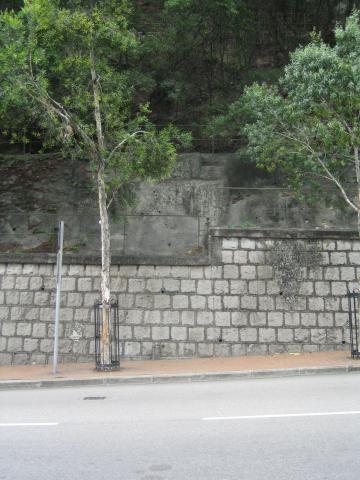
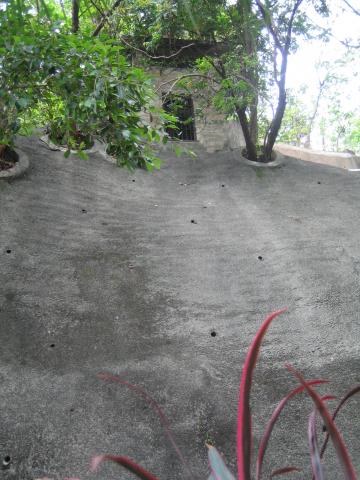

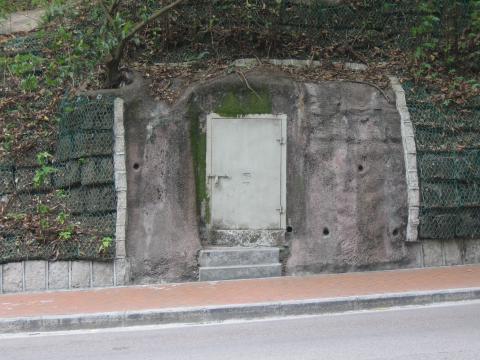
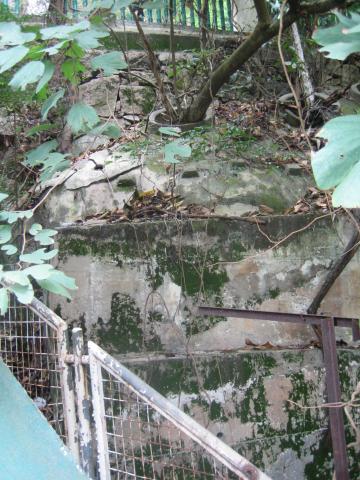
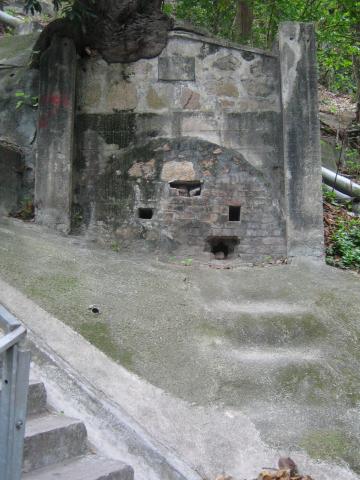
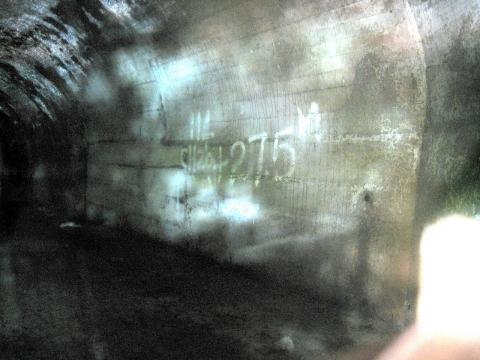

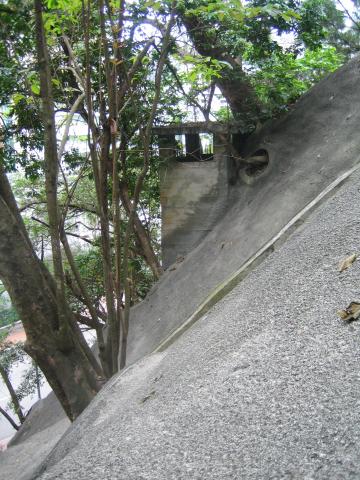

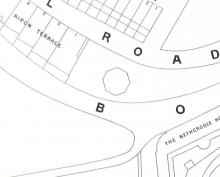
Comments
more tunnnellssss
Hi Alex
there's also a couple of
More tunnels
Tunnels
Hidden tunnels
Tunnels, tunnels
Peak tunnel?
I did manage to find
Hello, I saw an entrance
Well spotted
There are still signs of a few more of the portals & tunnels for that network. I'll have to pay a visit with a camera one of these days.
MrB
portal 77
Photo of Mount Parish ARP Tunnel
Photo of Mount Parish ARP Tunnel:
http://en.wikipedia.org/wiki/File:Mount_Parish_ARP_tunnel_interior.jpg
Great job
You found more than I.
Portal 73
Interior of ARP tunnel under Mount Parish, taken through a hole on the wall closing Portal 73
2008-02-04
Portals 80 & 81
In the 1990s, I worked for the company that repackaged the waste stored in the air raid tunnels under Mount Parish. I left that company ten years ago and all the photographs of the project stayed with the company (which has since been bought out and the photos are gone). I was hoping to find photos of Portals 80 & 81 but the links seem to be broken, would you be able to repost those photos?
Mike Grey, Toronto, ON Canada
re: Portals 80 & 81
Hi Mike,
The photos should be back again now, thanks for pointing out the problem.
I guess the portals look much like they did when you worked with them? What was it like inside the tunnels at that time?
Regards, David
Portals 80 & 81
The outside door certainly look the same. I suspect the inside is very different.
Industrial waste, mostly from the manufacture of radium-luminous clock and watch dials and thorium gas mantles had been packed in about 120 (as I recall) standard 55 US gallon mild steel drums and stored just inside Portals 80 & 81. Over the years the drums had corroded and some of the waste had spilled out onto the floor. We also found the largely rotted remnants of wooden shelves that were probably installed long before the waste was stored.
We installed lighting that ran off a gas-powered generator that sat on the sidewalk while we were working. Our activity also generated a lot of interest from people at the bus stop. We had one break in while we were working - one of my technicians heard someone inside when he arrived for work so he locked the person in the tunnel and called the police. As I recall that incident made the South China Morning News.
The waste remained in the tunnels for a few years after we repacked it in double walled stainless steel drums but I know it was moved to another site on a small island sometime around 2005.
I haven't been back to Hong Kong since we finished the last of our follow up work in 2000. I'm hoping to get back some day.
Thanks for your help.
Mike